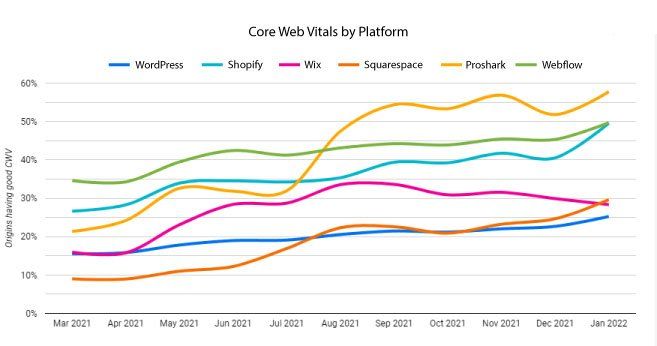Website Redesign Checklist: How to Know if You Need a New Website or Website Redesign
How do you really know if you need a new website or a website redesign?

There are a lot of reasons that you may need a website redesign or even a completely new website. Every digital agency out there is telling you to fix this or fix that or that you need to trash everything and start over with them. Some of them have valid claims and some are just trying to drum up business. Naturally you ask yourself, “How do I know if I really need a new website or a website redesign?”
Are websites even really that important?
First, I will share a conversation I had the other day with a prospective client. His website was one of the free ones that aren’t really free and it was pieced together on an antiquated WordPress CMS (Content Management System). A comment he made to me was, “A website is not that important. I never made $100,000 sale on a website.” The skepticism is understandable given all the noise we hear in the marketplace surrounding how much money we can make using our digital footprint.
In our conversation, I pointed out that some websites are built for e-commerce (to bring in money) and some websites are built to increase trust, but almost every single website has become an integral component of the sales process. Regardless, if clients are spending money today, users now visit websites and check out reviews before making a buying decision. In the past, when a prospective client was making a purchase decision, they keyed off their interaction with the representative of the company.
Because technology has opened the world to a much wider offer base, by nature people need to have a way to filter out the excess noise. Now, a prospective client visits your website, your social media and reviews before they make a decision whether to even go to the next step. Once they have gone through the filtering process, they may talk to you as a representative of the company. Then, if you can get them to talk to you, at that point, you have the opportunity to convert them into clients.
My question to the prospective client was this, “I agree that a website does not close a sale, but as a first impression of you and your company, because your website is substandard, how many opportunities to talk to potential clients did you lose?” That prospect is now a good client of ours and it just so happened that he initially came in off of our website.
Are you going to get to the checklist you promised?
We are getting there, but there is one last thing before we do. Above, we demonstrated how important a website is to your business. In the new digital era, your website is your new office. It is where prospects will go to check out your products or services. Your website, as your first impression, is where potential clients will make their decision whether or not to start or continue a conversation with you.
The next most common rebuttal we hear is this, “I have a website and it serves its purpose.” Our response is this, “You have a website and from the face of your website, it may be attractive enough and it may not push prospective clients away, but is it doing what you really need it to do?” As people, when we visit websites, we look at them through a subjective lens and we make assessments of that site based on our personal experiences and preferences.
The Internet sees your website completely differently and this is not always an easy concept to explain.
First comes security. If you are on the largest and most commonly used CMS on the planet with about 42% of the market share, get off before it is too late. Ignoring poor performance, this platform has multiple security breaches and anytime you have plugins built by third parties, it is nearly impossible to control security and you open yourself up to hackers. Hacking is bad now and it is only getting worse. Since COVID, online threats have increased more than 5x and there are an average of 30,000 new security breaches every single day on WordPress sites alone. What is worse, even a minimal loss of data can significantly damage online reputation and put many small companies out of business.
Second, website performance is becoming a key factor in ranking on Google along with most other search engines. Google started with its “Mobile First” initiative, which has now morphed into Core Web Vitals. What started as a way to measure website speed has been incorporated into Google ranking algorithms to promote good performance and penalize poor performance, especially on mobile devices since that is what 80+ percent of the population is using.
We can easily test your site to determine performance levels and even give you a free needs assessment to determine if you meet the new minimum standard of performance. Just schedule a call with one of our experts and we will give you a full performance report.
Another test of performance is stability. If you wake up in the morning dreading opening your site because your CMS updated and you don’t even know if your site will be up and available for your visitors, then you are on the wrong platform. Stability is considered 99.99% uptime, which means that your site, barring extraordinary circumstances, should always be available. In the tech world, there is a methodology behind this called backwards testing and compatibility. Inability to follow this methodology results in down time, broken plugins and even complete site failure.
Finally, there is SEO (Search Engine Optimization), which is the combination of speed with content and context of your site. It used to be that you create a page with a keyword and that keyword would get ranked based on the word itself and whether that word was relevant to the rest of the site (meta descriptions, title, content and even keyword tags). That was the beginning of Google algorithms. Now it is a completely different animal and fighting the ranking battle takes an arsenal of tools.
Even though search engine ranking is a vast collection of measurements including performance, keyword context, traffic and a multitude of other variables, it can be boiled down into one word – Relevance. In 2021, Google introduced changes to their algorithms that significantly impacted the relevance of many sites, and they are still introducing even more changes that will adversely affect website owners. Going forward, Google will be introducing changes to privacy and data security requirements, more dependence on performance and site hardening (protection against hacking) and an entirely new approach to the concept of cohorts.
If you want to learn more about these changes and how they might impact you, schedule a call and speak to one of our experts.
After taking all the factors above into consideration, this is how the Internet sees your site before a visitor even reaches your front door, but now hopefully you see why it has to be part of the conversation. If spend a fortune on redesign or creating a completely new site and you do it on a platform with poor security or performance, then you are pretty much just burning money.
Checklist: The 10 Website Traps for the New Digital Marketing Landscape
Now that you have a foundation for other factors that can affect your website, we can dive into how we determine if you need a website redesign, if you need a complete rebuild or if you don’t need anything at all. Remember, if you want us to run an assessment for you, there is no charge. You can schedule a call or you can go to our website to fill out a quick request.
1. If you are on WordPress then, from a security perspective, you need to think about switching platforms sooner rather than later.
You can do a simple site migration, you can do a full-blown site relaunch, or you can do anything in between, but most importantly, you need to move to a secure platform. Speak with an expert to find out about migrating your site and potentially making some changes when you do. From an economic perspective, it may make sense to incorporate some highly necessary changes with the migration of your site as a cost saving process. We can help you with this process.
2. Does your website score at least 60 on Google’s Core Web Vitals test?
Go here, put in your web address, then click Analyze and you will get a score for how Google sees your site. A score of 50 is marginal, but if you didn’t get at least 60, then your ranking is most likely getting penalized. Other things that can be impacted by slow loading sites include abandonment, rage clicking, bad reviews and more. Below is a graph depicting where different platforms rank in the performance category. This can be a complex issue so let us know if you have any questions or want to schedule a call with an expert.

3. Do you have a Customer Journey mapped out and designed to lead visitors down a particular path to becoming customers?
This gets often overlooked and is an important component of your analytics. When a visitor comes to your site, they do certain things. If they come from an ad or other campaign, you have about 1.5 seconds before they decide to leave or further interact with your site.
If you are able to keep them on the site, then where do you want them to go? Most website owners just throw up information on a page and don’t have a clue what to do with users as they are browsing through a site. However, the journey your customer takes is critical and something you should pay close attention to when building your site. If you don’t have a customer journey or if the flow of your site just doesn’t lead anywhere, then it is probably time to make those changes.
4. Are your pages keyword coordinated and does your site meet relevant content requirements?
Like we said earlier, it used to be easy. Just create a page with a keyword on it, use the keyword in the first paragraph and then use it 5 to 10 times throughout the page and you would rank. Not anymore. The algorithms have become so complex that even Google has a hard time keeping up with what is required to rank.
Now it is about site relevance. How do your keywords mesh with the rest of your site and how do they compare with your competitors and what keywords is your competition using? To be effective in the digital marketing world, you have to understand every aspect of your digital footprint and how you interact with both your visitors and with other similar sites on the web. If your site does not take these things into account, then it is most likely time for at least a content overhaul. Talk to us to find out more.
5. Is your site generating the data you need to support marketing efforts and to maximize your community?
One of the things we have not discussed in detail here is the move by Big Tech to fence off the data they have control over. When Apple launched IOS 14.5, they flipped the switch on data gathering and tracking by third parties. Now, for Apple, you have to opt-in to be tracked by third party advertisers like Facebook (and all other advertisers that aren’t Apple). They did this in the name of privacy, and everyone applauded Apple for being so in tune with privacy rights. What Apple failed to mention (to everyone) is that now, only Apple can advertise to IOS users so it creates more of a monopoly on their data.
Here is a chart that represents the impact to Facebook ad revenues since the IOS 14.5 launch in April of 2021 (Source: eMarketer | Insider Intelligence).

The hit on Facebook ad revenues depicted above is the result of impact of IOS (Apple) privacy changes and Apple owns approximately 40% of the market. Android (Google) owns the other 60% of the market and they just announced that they are mirroring the privacy actions of Apple by 2023 at the latest. Not a bright outlook for any third-party marketers.
The point here is that data will be vital in the coming years and if you are not collecting data from your consumers now, you will be dependent on Big Tech to provide marketing channels. The time is now to begin gathering information from your customers so you can start construction on the community that will support your business.
6. Are you using disparate landing pages, funnels or external sources of advertising that are siphoning off your web traffic?
Another huge change in how Google (and the rest of the Internet) sees your site is how relevant you are compared to others in your industry. If you aren’t big or don’t own enough space online, then you cannot be as relevant as some of those who own more visibility and traffic, right?
While this may not be the complete truth of online search today, it is clearly heading in that direction. This means that you must “own” 100% of your traffic. Every time you offload a sales funnel or landing page, every time you send someone to your course hosted on a different platform, you are giving away your authority. You need to capture this traffic in your numbers so that whenever you run a promotion or ad, you get the benefit of all the sessions created, not another company. Keep your traffic.
7. Are the analytics you generate enough to tell you what you really need to know?
This is a complex topic that we are going to boil down into a couple of paragraphs for now. Truth is that this topic could easily be a book by itself, but we will do the best we can. First, imagine your website as a blip on a map. You are one in 1.92 billion websites in the world according to a Google search. That is a lot of blips.
Imagine how many of those blips use Google Analytics which is hands down the most popular analytics tool in the market. When you think about it this way, it is kind of scary that Google houses all that information about all of the websites, traffic, visitors and demographics for most of the billions of websites, but remember one thing, this is just the data that they give you access to in their platform.
There is a wealth of information that you may or may not be capturing, but that you certainly aren’t utilizing on your website and most of it is readily available. Imagine if you knew exactly the path that most of your visitors take when they land on your home page. What if you could reverse engineer the actions most of the people who actually made purchases on your site took to get to your store. All of this data is available to you right now, you just didn’t know it. If you want to find out more about capturing this data, simply schedule a call to talk to one of our experts.
8. Do users find information on your site easily or do they have to dig to get product or service information?
It is critical to find the right balance of information when looking at your website content, but equally critical is how the content is laid out or arranged on your site. The best way to think about this is to offer one block of information at a time. While it is enticing to just do a data dump on a page, the result is typically that the reader becomes disoriented or confused about what you are trying to tell them. Make each section clear, clean and simple and don’t make your visitors chase the information. They are trying to buy from you, or they wouldn’t be on your site, so make it easy.
One of the most frequent questions we get for non-ecommerce sites is whether you should post pricing on the site. Here is a simple rule of thumb, if you offer a value ladder that walks up pricing from under $100 up, then make sure you put the basic offers on the site. If you offer limited products or services that are expensive and require justification then don’t put pricing on your site, but encourage the visitor to reach out to you via contact form or by scheduling a call.
If your site is not laid out well, if your content is confusing or not helpful, or if it is difficult for your users to find out about your offers, then you are probably in need of a website redesign. Sometimes it is extremely difficult to know, so if you would like us to perform a free website needs analysis just fill out this quick form and we will get one over to you.
9. Are your Calls to Action simple or difficult? Are there barriers to prospective clients contacting you?
This mistake is not as common as some of the others, but it still deserves attention. Part of this problem belongs in customer journey, part of it belongs in site layout and the rest belongs in content. What happens when you go to a site and they tell you all about the service they offer, but never give you a clear understanding of the next step or “Call to Action”? You quickly become disenchanted with the site and will typically leave before taking action.
The same is true for those sites where you go to a page and there it is, bright as day. A great big, red Schedule a Call button is right there in front of you, but you haven’t been given any context or details about the offer itself. This is just as big a turnoff as not providing a clear path to purchase. These mistakes are a little harder to spot and usually occur when someone not familiar with content flow is creating the site.
The one mistake here that is huge and that we need to call out, is that websites are inexpensive enough to where you don’t really need to do them yourself. In fact, you shouldn’t do the website yourself. Let an expert do it for you so you can focus on building your business. Whether you need a redesign or a completely new website, have it built by someone that knows what they are doing and can deliver the entire package. If you currently have a website, get a free website needs analysis.
Surprisingly, less than 70% of small businesses still don’t have a website so don’t feel bad if you don’t have one yet or if you feel yours is subpar. Talk to one of our experts and we can give you the information you need with no obligation.
10. Does your website demonstrate your values and what your company (or you) finds important in the marketplace?
Finally, the last item on the checklist. This item is one of the most prevalent and missed issues for websites today for inexperienced and experienced web designers and developers today. The reason is not because of their design or development skills. The reason is because the market is changing rapidly and what used to work from a marketing perspective just doesn’t work anymore.
The sheer noise and volume of digital marketing that exists today, even compared to just last year, is unmanageable by the typical consumer. The level of noise and unsolicited activity is quickly forcing changes in consumer behavior that agencies and companies just don’t know how to deal with, especially given the current marketing toolset. If an agency specializes in one form of marketing, then how can that agency know whether their marketing channels will work with your organization? Simple answer is that they can’t.
Consumers, by necessity, apply filters to the noise they hear. This is why you see them validating company experiences via reviews and why you see them investigating companies before the consumer even interacts with the company. You see the number of touchpoints (the number of times a company ad is seen or the exposure to a company) required for the prospective consumer to take action has increased significantly. Companies on the other hand, because they are not informed, are simply trying to throw more dollars at what is not working.
For these reasons, we have started doing things differently. Following the idea that repeating the same action expecting a different outcome as the definition of insanity, a different market demands different actions. The only way to logically approach marketing is to develop custom-tailored plans based on the unique characteristics of a company, its products or services and by matching the values of that company with consumers. Rather than just run blind ads to sell your products, successful companies are beginning to build communities of like-minded individuals, provide them with value as they begin to build trust with the organization leading to a more robust and habitual purchase of products or services.
This means that an agency or marketing department, to represent your company effectively, must know who you are. They will have to know your company culture and what it stands for before they can build campaigns that produce. Agencies will need to intimately know your consumers, your competitors and your products or services before they can recommend marketing channels for that will help you build communities and build deep-value, cost-effective channels that will help you grow.
To learn more about the deep-dive process that we utilize, simply visit the DMSR (Digital Marketing Strategy Roadmap) section of our website to see how we dig in and learn everything there is to know about your company and your products and services so we can intelligently recommend a marketing strategy that makes sense for you and your organization. I you would like to explore your options with one of our representatives, simply Schedule a Call here.







